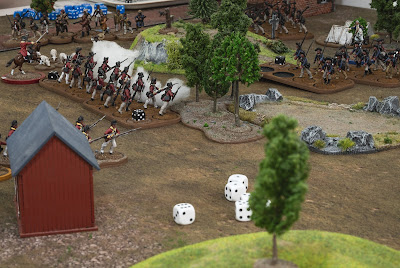As it's said "plans don't survive contact with the enemy". And my 2021 plans did not survive the first contact with my playmate. After serious consideration we decided that we'll focus the next months on the Napoleonic era. Specifically the Peninsular War.
The Peninsular War has always been a conflict I wanted to learn more about. Especially since I've done plenty of trips around the Iberian Peninsula and its landscapes are quite dear to me. From the wet cold North to the more arid South.
We determined that the system that seems more suitable to simulate the guerrilla warfare that occurred there is TooFatLardies Sharp Practice 2.
Guerra del Francès
As the conflict is quite broad, I've decided to start focusing in the nasty skirmishes and battles in the fierce Principality of Catalonia. What is commonly known as "La Guerra del Francès" (in Catalan). The conflict in Catalonia can even be considered its own autonomous conflict. While it has some links to the Peninsular War, there are many features exclusive to it.
To understand the importance of Catalonia, one must learn how Napoleon ordered its annexation to the metropolitan France, to keep it under his personal power, unlike the rest of the Peninsula that was given to his brother Joseph Bonaparte.
As the well known British historian Charles Oman said: "Far more than any other section of the Spanish nation do the Catalans deserve credit for their unswerving patriotism. Nowhere else was the war maintained with such resolution.". "There was no recognized leader, no general of repute, to head the rising of the province. Yet the attack on the invaders was delivered with a fierceness and a persistent energy that was paralleled in no other quarter of the Peninsula. For six years marshal after marshal ravaged the Catalan valleys, sacked the towns, scattered the provincial levies. But not for one moment did the resistance slacken; the invaders could never control a foot of ground beyond the narrow space that was swept by the cannon of their strongholds. The spirit of the race was as unbroken in 1813 as in 1808, and their untiring bands still held out in the hills, ready to strike at the enemy when the least chance was offered. Other provinces had equal or greater advantages than Catalonia for protracted resistance: Biscay, the Asturias, and Galicia were as rugged, Andalusia far more populous, Valencia more fertile and wealthy. But in none of these was the struggle carried on with such a combination of energy and persistence as in the Catalan hills.
First forces
To keep the first investment reasonable and versatile I'm planning to acquire enough miniatures to develop a French Light Column (as stated in the rulebook) manned by Voltigeurs and Dragoons. On the "allied" side, I'm pondering adding a Light Column that includes light infantry and riflemen, as well as some Catalan "Somatent" Skirmishers.
These forces will allow me to represent the clashes in the late war, from 1812 to 1813. The idea is to keep expanding them with new Catalan units like the Miquelets, as well as Spanish regulars and even Royal Marines that conducted raids over the coast.
In the black powder era there's few miniatures producers that can beat Perry Miniatures, so I'm planning to build the bulk of the forces with their amazing figures.
Terrain
Battleground is key for any miniature recreation and I have set my eyes on the Charlie Foxtrot Pantile collection as In my humble opinion is the one that represents more faithfully the Southern European / Mediterranean buildings. Unfortunately the consequences of Brexit and all its inconveniences may force me to simply purchase a token order.



No comments:
Post a Comment